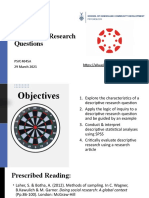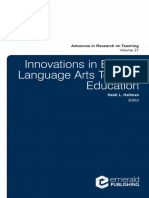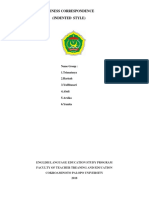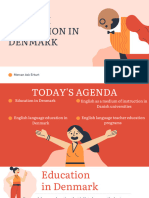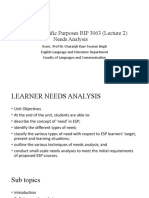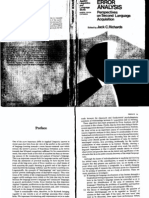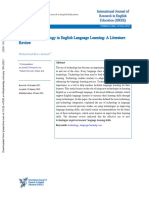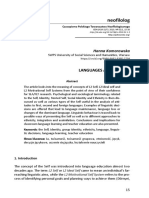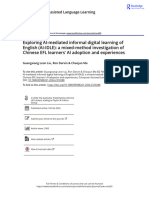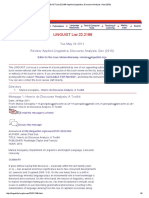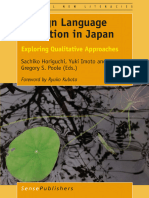0 ratings0% found this document useful (0 votes)
121 views142 pagesApproaches and Methods in Language Teaching
Uploaded by
d.soriaCopyright
© © All Rights Reserved
We take content rights seriously. If you suspect this is your content, claim it here.
Available Formats
Download as PDF or read online on Scribd
0 ratings0% found this document useful (0 votes)
121 views142 pagesApproaches and Methods in Language Teaching
Uploaded by
d.soriaCopyright
© © All Rights Reserved
We take content rights seriously. If you suspect this is your content, claim it here.
Available Formats
Download as PDF or read online on Scribd
You are on page 1/ 142
Approaches and Methods in
Language Teaching
aT Alp! otal. jay
Ae leew ds 32 Slers
AFAR leu yesolbeaty le
WE F545 po gilt
SONI FPF TY
OlogT Hove aaad
CAMBRIDGE LANGUAGE TEACHING LIBRARY
A seties covering central issues in language teaching and learning, by authors
who have expere knowledge in ther field
In thie series:
‘fect in Language Leariog edited by Jane Arnold i
Approaches and Methods ia Language Teaching, Sezond Editon, by
Jack C. Richards and Theodore S. Rodgers ;
‘Appropriate Methodology snd Social Context by Adrian Holliday
Beyond Training by Jack C. Richards
Classroom Decision-Making edited by Andrew Litejabn and
Michael P. Breen
Collaborative Action Research for Eaglish Language Teachers by Arne Burm :
Collaborative Language Learning and Teaching edited by David Nua
Communicative Language Teaching by Wiliam Littlewood
Designing Tasks forthe Communicative Classroom by David Numan
Developing Reading Skils by Francoise Grellet
Developments in English for Specific Purposes by Tony Dudley-Evans anid
‘Maggie Jo St. Jobn
Discourse Analysis for Language Teachers By Michael McCarthy
Discourse and Language Education by Evelyn Hatch
English for Academic Purposes by R. R. Jordan
English for Specific Purposes by Tor Hutchinson and Alan Waters
Establishing Sel-Acces: From Theory to Pracce by David Gardner and
Lindsay Miller
Foreign and Second Language Leamnng by Wiliam Littlewood
[Language Learing in latezcultral Perspecive edited by Michael Byram
‘ond Michael Fleming
‘The Language Teaching Matix by Jack C. Richards
Language Test Construction and Evaluation by). Charles Alderson,
Caroline Clapham, and Dianne Wall
Learne-Centednest a5 Language Education by an Tudor
“Managing Cursicular Innovation by Nurna Marker
Materials Development in Language Teaching edited by Brian Tominzon
[New leuigrants inthe United Sates edited by andre Lee McKay and
Sowing Cynthia Wong A
Psychology for Language Teachers by Marion Wiliams and
Robert L. Burden a
Research Methods in Language Learaing by David Nunan
Second Language Teacher Education edited by Jack C. Richards and
David Nena :
Society and the Language Classroom edited by Hywel Coleman
“Teacher Learning in Language Teaching edited by Donald Freeman
‘nd Jack C. Richorde
‘Teaching the Spoken Language by Gillian Brown and George Yule
Understanding Research in Second Language Leatnng by James Dean Brown
Using Surveys in Language Programs by James Dean Broion
Vocabulary: Description, Aequsiton and Pedagogy edited by Norbert Schmitt,
and Michael MeCarthy
Vocabulary, Semantics, and Language Educ
Cheryl Brown
‘Voices From the Language Classroom edited by Kathleen M. Bailey and
‘David Numan
by Evelyn Hatch and
Approaches and
Methods in
Language Teaching
Second Edition
Jack C. Richards
Southeast Asian Ministers of Education Organization
Regional Language Centce, Singapore
and
Theodore S. Rodgers
University of Hawaii
Manoa
CAMBRIDGE
UNIVERSITY PRESS
Contents
PUBLISHED BY THE PRESS SYNDICATE OF THE UNIVERSITY OF CAMBRIDGE :
‘The Pie Building, Trumpingron Stret, Cambiidge, United Kingdom ’
CAMBRIDGE UNIVERSITY PRESS
‘The Edinburgh Building, Cambridge cx2 2a, UK
40 West 20th Seret, New York, NY 10011-4211, USA
477 Wliamszown Road, Poet Melbourne, VIC 3207, Asselin A
Ruiz de Alarcon 13, 28014 Maced, Spats Preface vii
Dock House, The Wateront, Crpe‘Town 8001, South Afi
Part Major trends in twentieth-century language
pulworcambridge org teaching 1
© Cambridge Univers ress 2001+ 1 Abbtiet history of language teaching 3 .
This book sin copycght. Subjet ro searurory exception peeing ee
snd othe provision of relevant collecive lcening apeemens, eased nd aes fe
fee ee ce ene 3 The Oral Approach and Situational Language Teaching” 36
the wrisen permission of Cambridge Univeriey Press,
4 The Audiolingual Method 50... -
First published 2001
Sth printing 2002
Part Alternative approaches and methods 71
Printed in the Unive States of America
5 Total Physical Response 73
‘Typeface Sabon 1012/29 . .
Silent Way 81
A catalog record fr this book is evilable from the British Library. te eee
Library of Congress Cataloginin Publication Data 7 Community Language Learning ~ 90
Richards, Jack C. 8 Suggestopedia 100
Approaches and methods in language teaching / Jack C. Richacde and Theodore
Rodgers. ~ 2nd ed. ute 9 Whole Language 108
p.m, ~ (Cambridge language tesching libeary)
Includes bibliographical references and index
10. Multiple Intelligences. 115
ISBN 0-521-80565-9 -1N 0321 008633 (pb)
1 Langge and languages Sey snd tench Rodger, Tendo (Theodore 11. Newrolipguisic Programming
Stephen). Il. Tiele. IM. Series. . : 7 ee
PSLRA? 2001 lexical approach 132
‘418'.0071-de21_ 00-048624 bee eee
ISBN 0521 £03659 hardback 13 CompetencyBated Language Teaching 141
SN 052100843 3 paperback
i eee Part Ill Current commur
ative approaches 151
14 Communicative Language Teaching 153
Contents
15 The Natural Approach 178
16 Cooperative Language Learning ~ 192
17 Content-Based Instruction 204
18 Task-Based Language Teaching 223
19 The posemethods era 244
Author index 257
Subject index 261
Preface
This is a revised and reorganized version of the first edition, originally
published in 1986. More than half of the contents ofthis new edition has
been specially written for this edition. Since the first edition was pub~
lished, ic has become one of the most widely referced to books on teach-
ing methods. Since then, however, a great deal has happened in language
‘caching. In planning this new edition, we have therefore made a number
of substantial changes.
We have divided the book into three main parts:
Part Ideals with major trends in ewentieth-cencury language teaching.
‘The chapters in this section are substancally the same as those in the fist
edition but include an updated lis of references,
Part Il deals with alternative approaches and methods. This section
describes approaches and methods that have attracted support zt
diffecent times and in different places throughout the last 30 or 50 years,
bbut have generally not been widely accepted oz, in some cases, have not
maintained substantial followings. The chapters on Total Physical Re-
sponse, the Silent Way, Community Language Leaning, and Sug-
sgestopedia are shorter versions of chapters from the first edition. Addi.
tional and more recent references have been added to these chapters.
Because these methods are no longer widely used, a shorter treatment
seemed appropriate. Readers requiring fuller discussion ofthese methods
should consult the first edition, New chapters on Whole Language, Mul-
‘ple Ineligences, Neurolinguistic Programming, the lexical approach,
and Competency-Based Language Teaching complete Part Il. Although
these latter approaches share some features with communicative ap-
proaches in Part Il, we feel that they ace sufficiently distinct to be
grouped with the other approaches discussed in Part I.
Part II deals with current communicative approaches. It includes two
‘chapters from the firs edition ~ Communicative Language Teaching and
the Natural Approach ~ and new chapters on Cooperative Language
Learning, Content-Based Instruction, Task-Based Language Teaching,
and the post-methods era, New material has been added to the final
sections ofthe chapter on Communicative Language Teaching, and addi
tional references have been added to this chapter and to the one on the
Natural Approach.
Preface
‘The history of language teaching has been characterized by a search for
more effective ways of teaching second or foreign languages. For more
than 2 hundeed years, debate and discussion within the teaching profes-
sion have often centered on issues such as the role of grammar in the
language curriculum, the development of accuracy and fluency in teach-
ing, the choice of syllabus frameworks in course design, therole of vocab.
ulary in language learning, teaching productive and receptive skills, learn-
ing theories and their application in teaching, memorization and
learning, motivating learners, effective learning strategies, techniques for
teaching the four skill, and the role of materials and technology. Al-
‘though much has been done to clarify these and other important ques.
sions in language teaching, the teaching profession is continually explor-
ing new options for addressing these and other basic issues and the
effectiveness of different instructional strategies and methods in the
classroom,
tthe teaching of any subject matter is usually based on an analysis of
the nature of the subject itself and the application of teaching and learn~
ing principles drawn from research and theory in educational psychology.
The result is generally referred to 2s a teaching method or
You might also like
- Corpus Methodologies Explained - An Empirical Approach To Translation StudiesNo ratings yetCorpus Methodologies Explained - An Empirical Approach To Translation Studies245 pages
- (Advances in Research On Teaching, Volume 27) Heidi L. Hallman - Innovations in English Language Arts Teacher Education-Emerald Publishing (2017)No ratings yet(Advances in Research On Teaching, Volume 27) Heidi L. Hallman - Innovations in English Language Arts Teacher Education-Emerald Publishing (2017)252 pages
- (Continuum Studies in Translation) John Kearns (Editor) - Translator and Interpreter Training - Issues, Methods and Debates-Continuum (2008)No ratings yet(Continuum Studies in Translation) John Kearns (Editor) - Translator and Interpreter Training - Issues, Methods and Debates-Continuum (2008)240 pages
- H - Douglas Brown - Language Assessment-80-117No ratings yetH - Douglas Brown - Language Assessment-80-11738 pages
- Implementing Communicative Language Teaching in English As A Second Language ClassroomNo ratings yetImplementing Communicative Language Teaching in English As A Second Language Classroom10 pages
- Final Teacher Engagement Published ResearchNo ratings yetFinal Teacher Engagement Published Research54 pages
- Educational Change Amongst English Language College Teachers in China Transitioning From Teaching For General To Academic... (Yulong Li)No ratings yetEducational Change Amongst English Language College Teachers in China Transitioning From Teaching For General To Academic... (Yulong Li)157 pages
- Doing A Master's Dissertation in TESOL and Applied LinguisticsNo ratings yetDoing A Master's Dissertation in TESOL and Applied Linguistics267 pages
- Second Language Learning and Language Teaching StylesNo ratings yetSecond Language Learning and Language Teaching Styles48 pages
- Cheng and Fox (2017) - Beliefs About AssessmentNo ratings yetCheng and Fox (2017) - Beliefs About Assessment13 pages
- Confirmatory Factor Analysis PresentationNo ratings yetConfirmatory Factor Analysis Presentation11 pages
- Porte & MsManus 2019 Doing Replication R in ALNo ratings yetPorte & MsManus 2019 Doing Replication R in AL191 pages
- Exploring Students' Perceptions of AI-Powered Assistants in Enhancing English Speaking ProficiencyNo ratings yetExploring Students' Perceptions of AI-Powered Assistants in Enhancing English Speaking Proficiency9 pages
- The Use of Technology in English Language Learning Lit ReviewNo ratings yetThe Use of Technology in English Language Learning Lit Review11 pages
- Quantitative Research Design Dr. Azadeh AsgariNo ratings yetQuantitative Research Design Dr. Azadeh Asgari31 pages
- 04-Writing in The Disciplines-Research Evidence For Specificity - Ken Hyland PDFNo ratings yet04-Writing in The Disciplines-Research Evidence For Specificity - Ken Hyland PDF18 pages
- A Rasch Analysis On Collapsing Categories in Item - S Response Scales of Survey Questionnaire Maybe It - S Not One Size Fits All PDFNo ratings yetA Rasch Analysis On Collapsing Categories in Item - S Response Scales of Survey Questionnaire Maybe It - S Not One Size Fits All PDF29 pages
- 探索人工智能介导的非正式数字学习 英语(Ai Idle):混合方法调查 中国英语学习者人工智能的采用和体验No ratings yet探索人工智能介导的非正式数字学习 英语(Ai Idle):混合方法调查 中国英语学习者人工智能的采用和体验30 pages
- Applied Linguistics and Language Education Research Methods - Hung Phu Bui - 2024 - IGI Global - 9798369326039 - Anna's ArchiveNo ratings yetApplied Linguistics and Language Education Research Methods - Hung Phu Bui - 2024 - IGI Global - 9798369326039 - Anna's Archive719 pages
- 2022 HR Teaching Learning - Horizon ReportNo ratings yet2022 HR Teaching Learning - Horizon Report58 pages
- Introducing Second Language Acquisition Perspectives and Practices 1st Edition Kirsten M. Hummel Instant Access 2025100% (2)Introducing Second Language Acquisition Perspectives and Practices 1st Edition Kirsten M. Hummel Instant Access 2025117 pages
- EDBED1016 Learning and Teaching: Week 7 Planning For Practice: Connecting Pedagogy, Assessment and CurriculumNo ratings yetEDBED1016 Learning and Teaching: Week 7 Planning For Practice: Connecting Pedagogy, Assessment and Curriculum40 pages
- (Ebook) The Power of Critical Theory For Adult Learning and Teaching. by Stephen Brookfield ISBN 9780335211326, 9780335224388, 0335211321, 0335224385 Instant Download100% (1)(Ebook) The Power of Critical Theory For Adult Learning and Teaching. by Stephen Brookfield ISBN 9780335211326, 9780335224388, 0335211321, 0335224385 Instant Download152 pages
- Review: Gee's Discourse Analysis ToolkitNo ratings yetReview: Gee's Discourse Analysis Toolkit6 pages
- Communicative Syllabus Design and Testing: Dr. Ambreen Shahriar Dr. Ayesha Sohail Dr. Habibullah PathanNo ratings yetCommunicative Syllabus Design and Testing: Dr. Ambreen Shahriar Dr. Ayesha Sohail Dr. Habibullah Pathan26 pages
- (Critical New Literacies_ the Praxis of English Language Teaching and Learning (Pelt)) Sachiko Horiguchi, Yuki Imoto, Gregory S. Poole (Eds.)-Foreign Language Education in Japan_ Exploring QualitativeNo ratings yet(Critical New Literacies_ the Praxis of English Language Teaching and Learning (Pelt)) Sachiko Horiguchi, Yuki Imoto, Gregory S. Poole (Eds.)-Foreign Language Education in Japan_ Exploring Qualitative200 pages
- Baecher - Using Video 1st Proofs (Enabled For Commenting)No ratings yetBaecher - Using Video 1st Proofs (Enabled For Commenting)178 pages
- (Ebook) The Cambridge Guide To Pedagogy and Practice in Second Language Teaching (The Cambridge Guides Series) by Anne Burns, Jack C. Richards FullNo ratings yet(Ebook) The Cambridge Guide To Pedagogy and Practice in Second Language Teaching (The Cambridge Guides Series) by Anne Burns, Jack C. Richards Full158 pages
- Approach in Language Teaching (Jackc - Richards and Theodore S.rodgers) Versi 2No ratings yetApproach in Language Teaching (Jackc - Richards and Theodore S.rodgers) Versi 2142 pages
- Approaches and Methods in Language Teaching2 Paperback FrontmatterNo ratings yetApproaches and Methods in Language Teaching2 Paperback Frontmatter10 pages
- Approaches and Methods in Language Teaching - Jack Richards & Theodore Rodgers PDF100% (1)Approaches and Methods in Language Teaching - Jack Richards & Theodore Rodgers PDF90 pages


